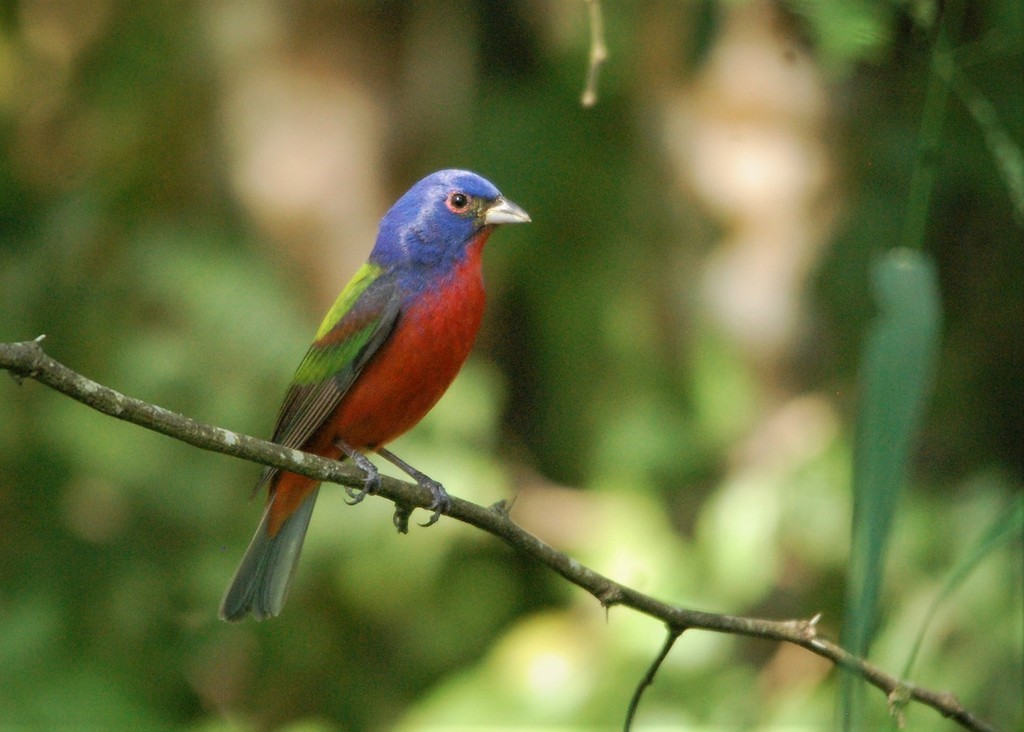
Painted buntings don’t know about the coronavirus.
Oblivious to our fears and “shelter in place” orders, they, along with other exhausted, migrating birds, are stopping in South Texas in April and early May to rest and feed before flying northward, where they will merrily mate and nest.
Though confined to our houses, yards and neighborhoods, we can still appreciate birds in our backyards and along nearby roads and trails. And hopefully, we will spot the stunning male painting bunting—a top prize for birders—as well as the less flashy, but no less lovely female.
The first time I saw a male painted bunting, which had perched in our Chinese tallow tree, I thought it was someone’s baby parrot. It looked like a child had spilled a box of crayons and colored him with the brightest ones. Royal blue adorns the bunting’s head. His back is lime green, and his rump and eye-ring, bright red—colors appearing to bleed into one another. New viewers gasp in excitement. A painted bunting inspired one nature photographer’s entire venture.
Spanish-speakers call this beauty “colorín sietecolores,” meaning “seven-colored goldfinch” or sometimes “mariposa pintata” or “painted butterfly.” In French, it is called “nonpareil” for “without equal.”
Victims of their own beauty, male birds were once trapped and kept as pets in the U.S. and often shipped to Europe. This was outlawed in the early 1900s, but, today, American black marketeers sell them for from $50 to $200. Also, trapping and selling them is legal in some Latin American countries.
At second molt, the male acquires his bright plumage, which never fades. The female painted bunting sports green feathers above and yellowish green below, with neither wing-bars nor streaking. Juveniles, which often visit during fall migration, look much like females, but after a year, a youth may wear some blue on his head.
Typical of a bird with a thick, cone-shaped beak, this bunting primarily eats seeds, foraging for them on the ground and amid thick, low bushes. It may seize a bush’s stem, drag it to the ground and secure it with a foot while devouring its seeds.
Though skittish, painted buntings may visit feeders to obtain millet or sunflower seeds, especially ones with cages around their tubes to discourage avian bullies.
This bunting also eats insects, snails and larvae—including grasshoppers, beetles, flies, and wasps—especially during mating season. These birds may rob a spider’s web, either prying forth a morsel or plunging right into it.
The western subspecies of the painted bunting (Passerina ciris ssp. pallidior) appears in the Valley; the eastern bird remains closer to the Atlantic. This bird’s family, Cardinalidae, includes other seed-eaters: cardinals, grosbeaks, dickcissels and fellow buntings. Its genus, Passerina, from “passer”, Latin for “sparrow”, includes six buntings and the blue grosbeak. “Ciris,” its species name, derives from the mythological bird into which the maiden Scylla is transformed. This bunting’s subspecies name, “pallidior,” ironically, means “paler” in Latin.
Painted buntings thrive in scrub, thickets, and fallow fields and along roadsides and woodland borders; they like semi-open areas with low plants. The eastern subspecies lives along the Atlantic coast, wintering in the Bahamas, Cuba, Mexico, Costa Rica and Panama, while western ones populate parts of the Midwest and South and winter in Mexico and Central America. Some overwinter in South Texas. During migration, the western subspecies molts at staging areas in Arizona and Mexico.
Despite the male’s brilliance, the painted bunting, being wary, can be challenging to find. Experienced birders listen for its song, a quick grouping of varied musical phrases. Its regular call is a loud chip or pwich, its flight call, a rising, buzzing vvvit. At sunrise, males tend to perch atop foliage and sing. During breeding season, the bird may forage more widely into wetlands and trees.
Painted buntings tend to wander. New Yorkers were thrilled one December in 2015, when a male painted bunting appeared outside a skating rink complex where native grasses had been planted. Vagrants are apt to be juveniles, but this one wore adult male plumage.
Male painted buntings defend their several-acre territories fiercely, pecking, wrestling and attacking other males with their wings—struggles that result in wounds, lost feathers, injured eyes and, occasionally, death. On wintering grounds, however, and during migration stopovers, they peck away peacefully on the ground with fellow seed-eaters.
Painted buntings nest throughout much of Texas from March through late August, though only uncommonly in the Valley, seemingly during our rainier years. They breed at sea level up to about 4700 feet. Though fierce in territorial disputes, the male ingratiates himself to his intended mate, fanning his feathers like a turkey as she pecks the ground. The birds are usually, but not always, monogamous; sometimes two females nest in one male’s territory.
The pair seeks a nesting site, usually from three to six feet high, assuring the locale contains perches, adequate cover and open feeding areas. Within about two days, the female constructs the tidy nest— a tightly woven cup made from twigs, stems, leaf skeletons, bark, rootlets and grass, lined with animal hair, grasses and sometimes snakeskin.
The female alone incubates her three to five speckled eggs, which hatch in about two weeks. Generally, only she feeds the nearly bare, lightly downed chicks, but the male may help if she nests again. Annually, the birds bear two or three broods. Chicks fledge in about two weeks.
Cowbirds frequently parasitize, or lay their own eggs in, painted bunting nests, expecting their hosts to raise cowbird chicks. Sometimes these buntings desert these nests, leaving their own young to die. Some report cowbird predation rates as high as 40 percent.
The Breeding Bird Survey has found notable declines of painted buntings, apparently due to habitat loss and degradation, as well as the illegal pet trade. The International Union for Conservation of Nature (IUCN) lists the species as “near threatened.”